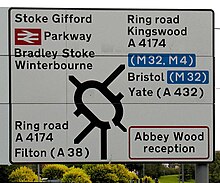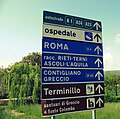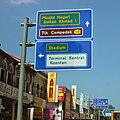 | |
| Category | Sans-serif |
|---|---|
| Classification | Grotesque Mixed Signage |
| Designer(s) | Jock Kinneir Margaret Calvert |
| Date created | 1963 |
 | |
| Sample | |

Transport is a sans serif typeface first designed for road signs in the United Kingdom. It was created between 1957 and 1963 by Jock Kinneir and Margaret Calvert as part of their work as designers for the Department of Transport's Anderson and Worboys committees.
History
Before its introduction, British road signs used the capitals-only Llewellyn-Smith alphabet that was introduced following the Maybury Report of 1933 and revised in 1955–57. Older signs, known as fingerposts, tended to use a variety of sans serif alphabets as supplied by their manufacturers. For the kinds of roads on which either of these alphabets was likely to be seen, legibility was not a pressing issue, but the planning and building of Britain's first motorway in the 1950s was a catalyst for change.
The Ministry of Transport appointed an Advisory Committee on Traffic Signs for Motorways under the chairmanship of Sir Colin Anderson in 1957 and Jock Kinneir and his assistant Margaret Calvert were appointed as graphic designers to it. All aspects of signing were investigated and tested, initially on the Preston bypass (1958, now part of the M6 motorway), before their introduction on the (London–Yorkshire) M1 motorway a year later. The committee looked at examples from other European countries as well as the USA but Kinneir and Calvert found them somewhat harsh and unsatisfactory. Instead, they developed a more rounded typeface with distinctive tails to 'a', 't', and 'l', and bar-less fractions, all of which helped legibility.
The department, seeing the successful early results of this work then appointed another committee, under the chairmanship of Sir Walter Worboys and again using Kinneir and Calvert as designers, to look at Traffic Signs for All-Purpose Roads. Work for this also resulted in the introduction of the pictogram signs based on those recommended by the 1949 United Nations World Conference on Road and Motor Transport.
Characteristics
Two forms of the typeface exist; Transport Medium and Transport Heavy. Both have the same basic form, but Transport Heavy is boldface, to allow easier readability of black letters on white backgrounds, such as those used on non-primary roads, while Transport Medium is lighter, and is used for white letters on dark backgrounds, such as the green primary-route signs.
The Transport fonts are the only ones allowed on UK road signs (except for motorway signs, where route numbers appear in their own separate typeface known as Motorway).
Only a limited number of symbols are available in Transport, mainly those commonly used in road signs, such as apostrophes, the pound sign and certain vulgar fractions such as ½ and ⅓. The original Transport fonts contained no diacritics, but since the publication of the 2016 Traffic Signs Regulations and General Directions includes grave accents for use on road signs in Scotland.
Other uses around the world
Although developed in the United Kingdom, the typeface has been used in many other countries around the world. In addition to the Crown dependencies, British overseas territories and some limited residual usage in Commonwealth states, the typeface is also used in Hong Kong, Iceland, Ireland, Greece (on non-motorway roads), and Portugal, and in much of the Middle East. Denmark uses a variation with added spacing and modified numerals, known as Dansk Vejtavleskrift. Italy and Spain use bolder variants, called Alfabeto Normale [it] in Italy and Carretera Convencional [es] in Spain. In many countries, the typeface has been adapted to include diacritics and other letters not used in English.
In countries where other scripts (such as the Perso-Arabic script) are used, Transport is often used for Latin transliterations. Road signs in the Republic of Ireland use all-caps Transport Heavy for English names; for Irish names, mixed-case Transport Heavy oblique is used with variants for A, a, i, M and N: script a, a curved i (which was formerly dotless), and tall versions of m and n.
In Indonesia, variable message signs/electronic signs have used Transport since April 2014.
Use examples
- Bangladesh – road signs
- Greece – road signs (Greek letters added)
- Hong Kong – road signs
- Iceland – road signs
- India – road signs
- Iran – road signs
- Ireland – road signs
- Indonesia – variable message signs
- Malaysia – road signs
- Malta – road signs
- Nepal – road signs
- Oman – road signs
- Portugal – road signs
- Qatar – road signs
- Singapore – road signs (Parking Area only)
- United Arab Emirates – road signs
- United Kingdom – road signs, government website and some government letters
Digitisations
The original Transport family, with its two weights, has been digitised by URW++.
New Transport
It is an updated and expanded version of the original typeface, been developed by Henrik Kubel of A2/SW/HK Limited and Margaret Calvert during 2012.
The original release includes six different weights (Thin, Light, Regular, Medium, Bold, Black) with complementary oblique stylings. It also has other features including text figures and small capitals. Semibold weight was added between 2018-08-29 and 2018-09-02.
Logo of the American cybersecurity and data backup company, Datto, Inc. used New Transport Medium typeface.
GDS Transport
It is a custom version of New Transport designed by New Transport designers, for use in the UK Government Digital Service web site (GOV.UK) in 2012, where it has been selected as the sole font for all text.
Transport New
An updated though unofficial family based upon Transport was first released by independent foundry K-Type in 2008. The family includes Light, Medium and Heavy weights along with true italics which were added in 2015.
This family is the main UI typeface of Untitled Goose Game made by House House in 2019.
Other
Jörg Hemker designed two typefaces that are inspired from the Transport typeface: FF Nort and FF Nort Headline. Both typefaces support Greek and Cyrillic.
Gallery
-
 A Scottish sign using the typeface on the Isle of Skye, with place names given in both Scots Gaelic and English, and distances shown in miles.
A Scottish sign using the typeface on the Isle of Skye, with place names given in both Scots Gaelic and English, and distances shown in miles.
-
 Example of the use of the typeface in road signs in Portugal
Example of the use of the typeface in road signs in Portugal
-
 Irish road sign using special character forms for A, a, i, and capitals M and N, for Irish text
Irish road sign using special character forms for A, a, i, and capitals M and N, for Irish text
-
 Use of Alfabeto Normale, as well as Alfabeto Stretto (top and bottom signs), in Italy
Use of Alfabeto Normale, as well as Alfabeto Stretto (top and bottom signs), in Italy
-
 The typeface is in use on Icelandic road signs. This example shows the locations of villages and farms in a rural area of the country.
The typeface is in use on Icelandic road signs. This example shows the locations of villages and farms in a rural area of the country.
-
 Use of the typeface within the Omani enclave of Madha, within the United Arab Emirates. The Latin alphabet text has been translated from the Arabic, which is also shown.
Use of the typeface within the Omani enclave of Madha, within the United Arab Emirates. The Latin alphabet text has been translated from the Arabic, which is also shown.
-
 Another example of the typeface in use in the Middle East, this time in Kuwait.
Another example of the typeface in use in the Middle East, this time in Kuwait.
-
Use of the Transport font in Kerala, India in both Malayalam and English
-
The Transport font is used in several ex-British colonies, such as this one in Kagera Region, Tanzania
-
 Latest street direction sign with Transport typeface in Mongkok, Hong Kong
Latest street direction sign with Transport typeface in Mongkok, Hong Kong
-
 Gantry road sign with Transport typeface used in Malaysia
Gantry road sign with Transport typeface used in Malaysia
-
 Use of the typeface in Greece
Use of the typeface in Greece
See also
- Motorway (typeface) — Another font used for motorway route numbers on motorways, also designed by Kinneir & Calvert.
- Rail Alphabet — The equivalent font on Britain's railways, also designed by Kinneir & Calvert.
- Johnston (typeface) — The London Underground font, designed by Edward Johnston.
- Public signage typefaces
- Highway Gothic — The North American equivalent that is also used widely around the world for traffic signs.
- DIN 1451 — The German equivalent.
References
- ^ Design Museum — Jock Kinneir + Margaret Calvert, URL accessed 16 May 2006
- Calvert, Margaret. "New Transport". A2-Type. Retrieved 1 March 2016.
- "Traffic Signs Manual (Chapter 1)" (PDF). p. 18. ISBN 9780115536014. Archived from the original (PDF) on 16 December 2023. Retrieved 16 December 2023.
- ^ "The Traffic Signs Regulations and General Directions 2016". legislation.gov.uk. Retrieved 22 July 2024.
- FAQ §3.6 Fonts on signs from Chris's British Road Directory
- Indonesia Transport Minister's Rule No. 13/2014 Archived 6 October 2014 at the Wayback Machine
- "Transport". MyFonts. URW++. Retrieved 1 March 2016.
- "New Transport". New Transport. Retrieved 19 June 2017.
- New Transport, Typeface (2019-08-29)
- New Transport, Typeface (2019-09-02)
- "A few notes on typography". GOV.UK. Retrieved 19 June 2017.
- "Can I use the GOV.UK fonts? – Design in government". designnotes.blog.gov.uk.
- "Transport New". K-Type. Retrieved 17 June 2017.
- "FF Nort". MyFonts. Retrieved 12 March 2021.
- "FF Nort Headline". MyFonts. Retrieved 12 March 2021.
External links
- Traffic signs working drawings: TSRGD 2016 schedule 17
- World Transportation Organization The world transportation organization (The Non-Profit Advisory Organization)
New Transport
- New Transport – sale, history and .pdf specimen
- A2-TYPE page
| Traffic signs | |||||||||||||||
|---|---|---|---|---|---|---|---|---|---|---|---|---|---|---|---|
| Signs |
| ||||||||||||||
| By country |
| ||||||||||||||
| Lights | |||||||||||||||
| Typefaces | |||||||||||||||
| International conventions |
| ||||||||||||||
| National standards | |||||||||||||||
| Comparisons | |||||||||||||||